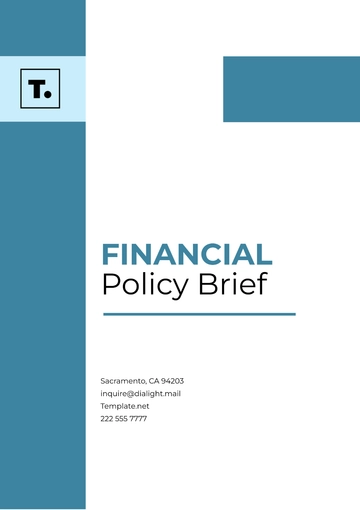Free Tax Policy Chapter Outline

Prepared By: [Your Name]
Chapter 1: Introduction to Tax Policy
1.1 Definition and Purpose of Tax Policy
Understanding Tax Policy: Tax policy refers to the principles and laws that guide how taxes are levied, collected, and managed by the government. Its primary aim is to generate revenue for public expenditure, redistribute wealth, and influence economic behavior.
Objectives of Tax Policy: The main objectives include raising revenue for government services, redistributing income to reduce inequality, and promoting economic stability and growth.
1.2 History of Tax Policy
Evolution of Tax Systems: Early tax systems in ancient civilizations, such as Mesopotamia and Egypt, primarily relied on agricultural produce and labor taxes. The Roman Empire introduced more structured taxes, including customs duties and sales taxes.
Historical Milestones in Tax Policy Development: The introduction of income tax in Britain in 1799 to fund the Napoleonic Wars and the establishment of the modern tax system in the U.S. with the Revenue Act of 1913 are significant milestones.
1.3 Key Principles of Tax Policy
Equity: Progressive taxes help ensure fair tax distribution.
Efficiency: Minimizing economic distortions and administrative costs.
Simplicity: Making the tax system easy to understand and comply with.
Transparency: Communicating tax policies and ensuring accountability.
Chapter 2: Types of Taxes
2.1 Income Taxes
Personal Income Tax: Taxes on individuals' earnings from wages, investments, and other sources. For example, in the U.S., personal income tax rates range from 10% to 37%.
Corporate Income Tax: Taxes on corporate profits. In 2023, the U.S. federal corporate tax rate was 21%.
2.2 Consumption Taxes
Sales Tax: Levied on the sale of goods and services. States like California have a base sales tax rate of 7.25%.
Value-Added Tax (VAT): A multi-stage tax collected at each stage of production and distribution. Common in Europe, with standard rates around 20%.
Excise Tax: Applied to specific goods like alcohol, tobacco, and fuel. For example, the federal excise tax on gasoline in the U.S. is 18.4 cents per gallon.
2.3 Property Taxes
Real Estate Tax: Based on the value of property owned. In New York City, property tax rates vary but average around 1.7%.
Inheritance and Estate Taxes: Taxes on the transfer of wealth upon death. The U.S. federal estate tax rate can be up to 40%.
2.4 Payroll Taxes
Social Security Contributions: Collected from employers and employees to fund social security programs. In the U.S., the rate is 6.2% for both employees and employers.
Medicare Taxes: Collected at a rate of 1.45% from both employers and employees to fund healthcare for seniors.
2.5 Other Taxes
Capital Gains Tax: Levied on profits from the sale of assets. Long-term capital gains in the U.S. are taxed at rates of 0%, 15%, or 20%.
Wealth Tax: A tax on the net worth of individuals. While not widely used, some countries like Spain have such taxes.
Chapter 3: Tax Policy Design
3.1 Tax Base
Definition and Importance: The tax base is the total amount of assets or income that can be taxed. A broader tax base allows for lower rates and fewer economic distortions.
Broad vs. Narrow Tax Base: A broad tax base includes a wide range of income and assets, minimizing the need for high rates. A narrow base might require higher rates to generate sufficient revenue.
3.2 Tax Rate Structure
Progressive Taxes: Higher income earners pay a higher percentage of their income. For example, U.S. federal income tax rates increase with income brackets.
Regressive Taxes: Lower-income earners pay a higher percentage of their income. Sales taxes can be regressive.
Proportional Taxes: A flat tax rate applied uniformly. Some countries, like Estonia, use a flat income tax rate.
Marginal vs. Effective Tax Rates: The marginal tax rate is the rate on the last dollar earned, while the effective tax rate is the overall rate paid. For instance, a person in the 32% marginal tax bracket in the U.S. may have an effective tax rate of 20%.
3.3 Tax Expenditures
Deductions: Taxable income reductions, like U.S. mortgage interest deductions.
Credits: Direct reductions in tax liability, like the Earned Income Tax Credit (EITC).
Exemptions: Income not subject to tax, like certain municipal bond interest.
3.4 Compliance and Enforcement
Role of Tax Authorities: Organizations like the IRS in the U.S. are responsible for tax collection and enforcement.
Methods of Enforcement: Includes audits, penalties, and legal action.
Impact of Non-Compliance: Erodes revenue base and undermines fairness. For example, the U.S. tax gap is estimated to be over $400 billion annually.
Chapter 4: Economic Effects of Taxation
4.1 Taxation and Economic Behavior
Labor Supply: Higher taxes can discourage work effort. For instance, high marginal tax rates might reduce the incentive to work overtime.
Savings and Investment: Taxes on interest, dividends, and capital gains can affect saving and investment decisions.
4.2 Tax Incidence
Who Bears the Tax Burden?: The economic burden of taxes may differ from the legal burden. Consumers often bear the burden of sales taxes.
Shifting and Sharing of Tax Burden: Tax burden can shift between buyers and sellers depending on price elasticity. For example, a tax on cigarettes may be passed on to consumers at higher prices.
4.3 Taxation and Economic Growth
Impact on GDP: Taxes can affect overall economic activity. Some studies suggest that high corporate taxes may stifle investment and growth.
Short-term vs. Long-term Effects: Immediate revenue gains vs. long-term economic distortions. For example, cutting corporate taxes might boost short-term investment but increase deficits.
4.4 Taxation and Income Distribution
Effects on Income Inequality: Progressive taxes can reduce inequality, while regressive taxes may exacerbate it.
Redistribution Policies: Government programs funded by taxes can help reduce poverty and inequality. For instance, social security and unemployment benefits.
Chapter 5: Tax Policy and Government Budgets
5.1 Revenue Generation
Role of Taxes in Funding Government Activities: Taxes finance public services like healthcare, education, and infrastructure.
Budgetary Balance and Deficits: The balance between tax revenue and government spending. Persistent deficits can lead to increased public debt.
5.2 Expenditure Policies
Link between Tax Revenue and Government Spending: Ensures that sufficient funds are available for public services.
Fiscal Policy and Its Impact on the Economy: Using tax and spending policies to manage economic cycles. For example, stimulus packages during recessions.
5.3 Fiscal Federalism
Tax Policies at Different Government Levels: Federal, state, and local tax policies. In the U.S., states have autonomy in setting income and sales taxes.
Intergovernmental Transfers and Fiscal Coordination: Mechanisms for resource distribution among different government levels. For instance, federal grants to states.
Chapter 6: International Taxation
6.1 Global Tax Systems
Comparison of Tax Systems across Countries: Variations in tax structures and rates. For example, Scandinavian countries have high VAT and income tax rates.
Tax Competition and Harmonization: Efforts to standardize tax policies to prevent harmful tax competition. The EU's attempts at tax harmonization.
6.2 Tax Treaties
Purpose and Types of Tax Treaties: Agreements to avoid double taxation and prevent tax evasion. The U.S. has treaties with over 60 countries.
Double Taxation Avoidance Agreements (DTAAs): Ensure that income is not taxed twice in different jurisdictions.
6.3 Transfer Pricing and Base Erosion
Multinational Corporations and Profit Shifting: Companies shifting profits to low-tax jurisdictions. For instance, Apple's use of Ireland for tax purposes.
BEPS (Base Erosion and Profit Shifting) Initiative: OECD's efforts to combat tax avoidance by multinational companies.
6.4 Tax Havens and Evasion
Identification and Impact of Tax Havens: Countries with low or no taxes that attract foreign businesses. Examples include the Cayman Islands and Luxembourg.
Measures to Combat Tax Evasion: International cooperation and stricter regulations. The Common Reporting Standard (CRS) for automatic exchange of financial information.
Chapter 7: Current Issues in Tax Policy
7.1 Tax Reform Proposals
Recent and Proposed Changes in Tax Policy: Discussion on U.S. tax reforms under the Trump and Biden administrations.
Debates and Controversies: Arguments for and against wealth taxes, flat taxes, and corporate tax cuts.
7.2 Technological Impact on Taxation
Digital Economy and Taxation: Challenges in taxing digital services. The OECD's digital tax proposal.
Blockchain and Tax Administration: Using blockchain for transparency and efficiency in tax collection.
7.3 Environmental Taxes
Carbon Tax: Tax on carbon emissions to combat climate change. Examples include Canada's carbon pricing mechanism.
Taxes on Pollutants and Natural Resources: Levies on activities that harm the environment. For instance, plastic bag taxes.
7.4 Social and Ethical Considerations
Fairness in Taxation: Ensuring that tax policies do not disproportionately affect low-income groups.
Tax Policy and Social Justice: Using tax policy to address social inequalities. For example, progressive income taxes and social welfare programs.
Chapter 8: Conclusion
8.1 Summary of Key Points
Recap of Main Themes and Concepts: Review the principles, types, design, and effects of tax policy.
8.2 Future Directions in Tax Policy
Emerging Trends and Challenges: Impact of globalization, technology, and demographic changes on tax systems.
Potential Areas for Further Research and Reform: Innovative tax solutions and policy adjustments.
Appendices
A. Glossary of Tax Terms
Definitions of Key Tax Terminology: E.g., "Tax Base," "Marginal Tax Rate," "Tax Expenditure."
B. Major Tax Legislation Timeline
Chronology of Significant Tax Laws: For instance, the U.S. Revenue Act of 1913, the Tax Reform Act of 1986, and the Tax Cuts and Jobs Act of 2017.
C. Case Studies
Examples of Tax Policies from Different Countries: Analysis of the tax systems in Sweden, Singapore, and Brazil.
References
1. Books and Articles
Academic and Professional Sources: Books like "Taxation: Theory and Practice" by David G. Davies, and articles from journals like the "National Tax Journal."
2. Government Reports and White Papers
Official Publications: Reports from the OECD, IMF, and national tax authorities.
3. Data Sources and Statistics
Reliable Data Repositories: Data from the World Bank, U.S. Internal Revenue Service (IRS), and Eurostat.
- 100% Customizable, free editor
- Access 1 Million+ Templates, photo’s & graphics
- Download or share as a template
- Click and replace photos, graphics, text, backgrounds
- Resize, crop, AI write & more
- Access advanced editor
Streamline your tax policy analysis with Template.net's Tax Policy Chapter Outline Template. This editable and customizable template includes sections for policy objectives, legislative framework, economic impact, and case studies. Editable in our AI Editor Tool, it offers a structured format for developing a comprehensive and well-organized chapter outline, ensuring a clear and effective presentation of tax policy issues.
You may also like
- HR Policy
- Restaurant Policy
- Company Policy
- Accounting Policies and Procedures
- Website Policy
- Privacy Policy
- Safety Policy
- School Policy
- IT and Software Policy
- Law Firm Policy
- Construction Policy
- Interior Design Policy
- Travel Agency Policy
- Education Academic Policy
- Security Policy
- Real Estate Policy
- Expense Policy
- Software Policy





























